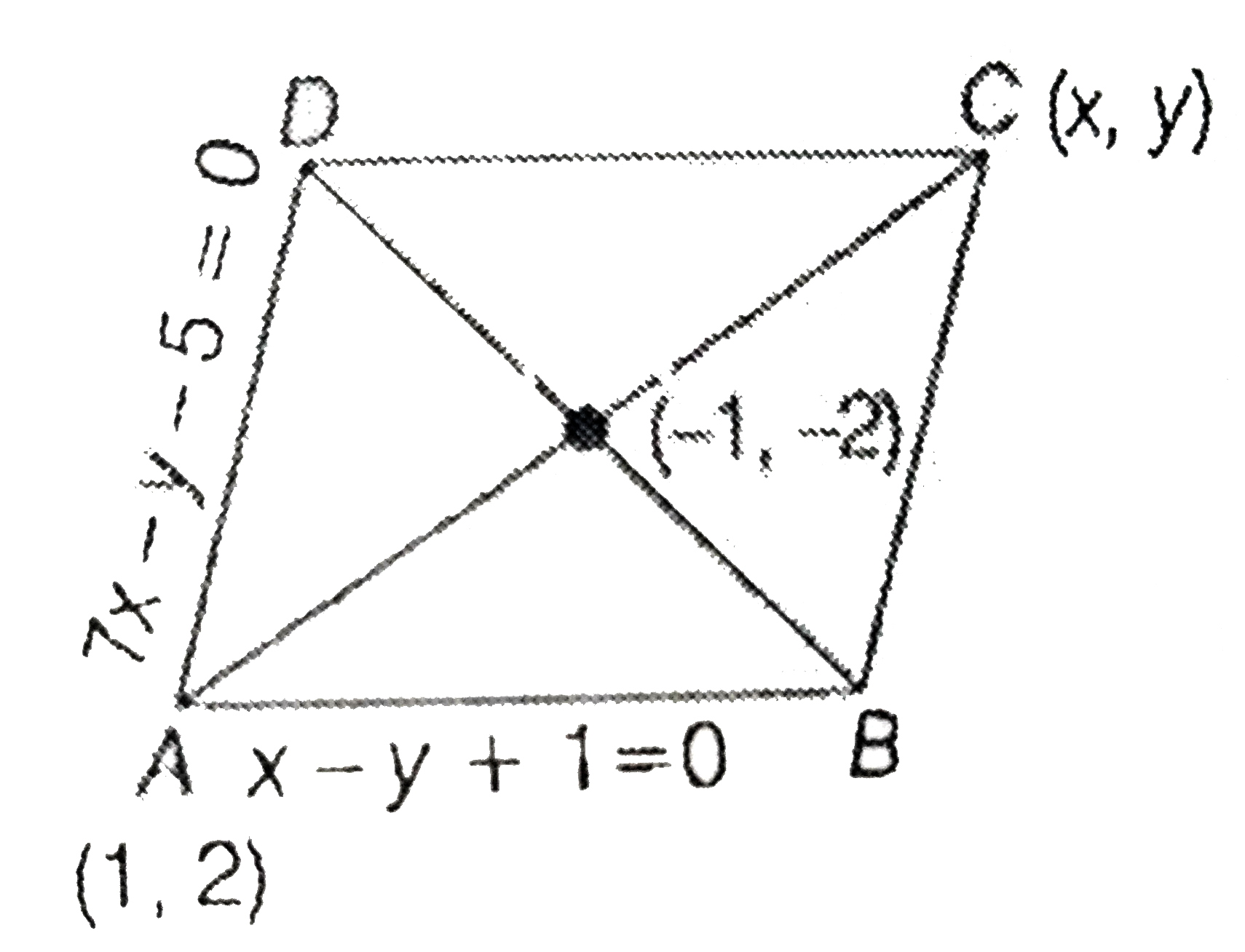Two sides of a rhombus are along the lines,x−y+1=0 and 7x−y−5=0 . If its diagonals intersect at (−1,−2) , then which one of the following is a vertex of this rhombus ? (1) (−3,−9) (2) (−3,−8) (3) (13,−83) (4) (−103,−73)
(−3,−9)
(−3,−8)
(13,−83)
(−103,−73)
As the given lines x−y+1=0 and 7x−y−5=0 are not parallel, therefore they represent the adjacent sides of the rhombus.
On solving x−y+1=0 and 7x−y−5=0, we get x=1 and y=2. Thus, one of the vertex is A(1,2).

Let the coordinate of point C be (x,y).
Then, −1=x+12 and −2=y+22
⇒x+1=−2 and y=−4−2
⇒x=−3
⇒y=−6
Hence, coordinates of C=(−3,−6)
Note that, vertices B and D will satisfy x−y+1=0 and 7x−y−5=0, respectively.
Since, option (c) satisfies 7x−y−5=0, therefore coordinate of vertex D is (13,−83).
Topper's Solved these Questions
- STRAIGHT LINE AND PAIR OF STRAIGHT LINESBook:IIT JEE PREVIOUS YEARChapter:STRAIGHT LINE AND PAIR OF STRAIGHT LINESExercise:AREA AND FAMILY OF CONCURRENT LINES (Objective Questions II) (Only or more than one correct option)
Explore 1 Video
- STRAIGHT LINE AND PAIR OF STRAIGHT LINESBook:IIT JEE PREVIOUS YEARChapter:STRAIGHT LINE AND PAIR OF STRAIGHT LINESExercise:AREA AND FAMILY OF CONCURRENT LINES (Match the columns)
Explore 1 Video
- STRAIGHT LINE AND PAIR OF STRAIGHT LINESBook:IIT JEE PREVIOUS YEARChapter:STRAIGHT LINE AND PAIR OF STRAIGHT LINESExercise:ANGLE BETWEEN STRAIGHT LINE AND EQUATION OF ANGLE BISECTOR (Analytical & Desriptive Questions)
Explore 3 Videos
- SOLVED PAPER 2019Book:IIT JEE PREVIOUS YEARChapter:SOLVED PAPER 2019Exercise:Paper -2 section-3
Explore 4 Videos
- THEORY OF EQUATIONSBook:IIT JEE PREVIOUS YEARChapter:THEORY OF EQUATIONSExercise:SOME SPECIAL FORMS
Explore 18 Videos
Similar Questions
Two sides of a parallelogram are along the lines x+y=3 and x−y+3=0 .If its diagonal intersect at (2,4) then one of its vertex is
View SolutionTwo sides of a Rhombus ABCD are parallel to the lines x−y=5 and 7x−y=3. The diagonals intersect at (2,1) then the equations of the diagonals are
View Solution
Knowledge Check
Two sides of a parallelogram are along the lines x+y=3 and x=y+3. If its diagonals intersect at (2, 4) , then one of its vertices is
A(2, 6)B(2,1)C(3, 5)D(6,3)The sides of a rhombus ABCD are parallel to the lines x−y+2=0 and 7x−y+3=0, If the diagonals of the rhombus intersect at P(1,2) and the vertex A (different from the origin) is on the y-axis then the ordinate of A is:
A2B52C74D72One side of a rectangle lies along the line 4x + 7y + 5 = 0. Two of its vertices are (-3, 1) and (1, 1). Which of the following is not an equation of the other three straight lines?
A14x - 8y = 6B7x - 4y = -25C4 x + 7y = 11D14 -8y = - 25
Two adjacent sides of a rhombus are 2x+3y=a−5 and 3x+2y=4−2a and its diagonals intersect at the point (1,2) then a can be
View SolutionSides of a rhombus are parallel to x+y=0,7x=y. Its centre is (2,7), then its diagonals are
View SolutionTwo sides of a rhombus ABCD are parallel to the lines y = x + 2 and y = 7x + 3 If the diagonals of the rhombus intersect at the point (1, 2) and the vertex A is on the y-axis, then vertex A can be
View SolutionTwo sides of a rhombus lying in the first quadrant are given by 3x−4y=0 and 12x−5y=0. If the length of the longer diagonal is 12, then find the equations of the other two sides of the rhombus.
View SolutionThe sides of a rhombus are parallel to the lines x+y−1=0 and 7x−y−5=0. It is given that the diagonals of the rhombus intersect at (1, 3) and one vertex, A of the rhombus lies on the line y=2x . Then the coordinates of vertex A are (a)(85,165) (b) (715,1415) (c)(65,125) (d) (415,815)
View Solution

